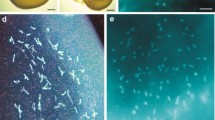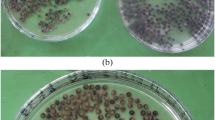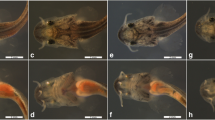Summary
-
I.
Mating and Inseminating of Eggs.
-
1.
The crossing of 4n- ♀x2n- ♂ is usually easy to accomplish. However, we know of a local 4n form which can be mated only with difficulties, suggesting that the female copulatory apparatus must be undergoing structural changes. The same females, when mated, inseminate only a small percentage of their eggs, indicating that the inseminating apparatus also is not normal.
-
2.
As a rule, mated 4n females from regions of purely parthenogenetic races inseminate their eggs badly, i.e. their inseminating apparatus is defective or cannot be used properly (Table 5, 10).
-
3.
Mated 4n females from transition regions usually inseminate their eggs well. Their inseminating apparatus seems to be more or less intact and is used properly (Table 6, 10).
-
4.
Noninseminated eggs give rise to parthenogenetic 4n- ♀ and inseminated eggs to triploid intersexes. Therefore to evaluate the true F1 the 4n- ♀ must be disregarded (Table 10).
-
II.
Constitution of the First Filial Generation:
-
1.
Each intersex gonad is made up of four subunits, ovarioles (E) and/or testicular follicles (H) in any possible combination (Figs. 1–3, Table 8).
-
2.
From this we infer that the individual subunits of a gonad are to a large extent independently of each other.
-
3.
From the fact that our material contains also all calculated combinations of all possible types of both gonads in the intersexes we conclude that the two gonads of each individual are at least largely independent of each other (cp. Table 9).
-
4.
As expected, the combinations of extreme types of gonads are the rarest (4E:4H; 3E 1H:4H). The contrary is true for the combinations with the smallest differences (4E:3E 1H:4H:1E 3H) (cp. Table 9).
-
5.
However, the extreme predominance of the combinations 4E:4E and 4H:4H needs further explanation.
-
6.
The analyzed F1's have the common feature that all degrees of intersexuality occur in each one.
-
7.
But they differ greatly in the values for the class 0 (4E:4E) and the class 100 (4H:4H), as well as in the ♀/♀-like range and the ♂-like range (cp. Table 8).
-
8.
As a rule the larger the proportion of eggs inseminated by a mated P-female the larger the number of individuals in the ♂-like range and the smaller the number in the ♀/♀-like range (type Schöfflisdorf). However, the contrary may also occur (type Generoso) (cp. Table 6).
-
9.
As a rule the smaller the proportion of eggs inseminated by a mated P-female the larger the number of individuals in the ♀/♀-like range and the smaller the number in the ♂-like range of intersexuality. (cp. Table 10).
-
III.
Interpretation.
-
1.
In triploids the proportion of F:M is balanced, therefore they are intersex.
-
2.
In the course of parthenogenetic generations, so we consider, this balance is upset in favor of F by mutations reducing the valency of M.
-
3.
In crosses of 4n- ♀ from transition regions the first generation offspring comprises few 4n- ♀ and many intersexes which mostly lie within the ♂-like range. In this is so because the females still inseminate the eggs well and the valency of M is not yet reduced.
-
4.
In crosses of 4n- ♀ from transition regions in which the evolution from bisexual to 2n parth. to 4n parth. is close to completion the first generation offspring comprises few 4n- ♀ and many intersexes which mostly lie within the ♀-like range. In this case the inseminating apparatus is still normal though the valency of M is already much reduced.
-
5.
Finally, crosses of 4n- ♀ from pure tetraploid regions result in an offspring with many 4n- ♀ and few intersexes which are predominantly of the ♀-like type. This occurs because the inseminating apparatus is only imperfectly functioning and the valency of M is much reduced.
-
6.
Since in F1 gonads all combinations of E and H subunits occur and since equally all combinations of different gonad types are found it can be concluded that the sexual determination is essentially accidental.
Similar content being viewed by others
Literatur
Astaurov, B. L.: Experimental alterations of the developmental cytogenetic mechanismus in Mulberry silkworms: Artificial Parthenogenesis, Polyploidy, Gynogenesis and Androgenesis. Advanc. Morphogenes.6, 200–257 (1967). Hier dieBombyxliteratur.
Dobzhansky, T.: Genetical and environmental factors influencing the type of intersexes inD. melanogaster. Amer. Naturalist.64, 261–271 (1930).
Goldschmidt, R.: Die sexuellen Zwischenstufen S. 1–517. Berlin: Springer 1931. Hier Kosminsky, 1909.
Hofmann, O.: Über die Naturgeschichte der Psychiden. Diss. Erlangen1859, S. 1–54.
Humbel, E.: Analyse männchenähnlicher Intersexe vonS. triquetrelle F.R. Rev. suisse Zool.57, 155–231 (1950).
Lautenschlager, F.: Die Embryonalentwicklung der weiblichen Keimdrüsen bei der PsychideSolenobia triquetrella. Zool Jb., Abt. Anat. u. Ontog.56 (1932).
Mosbacher, G.: Über den Einfluß der Temperatur auf den Intersexualitätsgrad beiLymantria dispar L. Verh. dtsch. zool. Ges.30 (Suppl.-Bd.), 509–521 (1966). Hier weitere Lit. zum thema der Wirkung von Außenfaktoren auf die Geschlechtsbestimmung.
Mosbacher, G.: Experimentelle, zytologische und entwicklungsgeschichitliche Untersuchungen über Intersexualität bei Lymantria. Im Druck.
Narbel-Hofstetter, M.: La cytologie de l'œuf issu du croisement de la femelle parthénogénétiqueLuffia avec le mâle deL. lapidella. Chromosoma (Berl.)18, 153–173 (1966).
Pardi, L.: I primi processi dello svilluppo nell'uovo fecondato delle razze tetraploidi-parthenogenetiche diSolenobia triquetrella F.R. Chromosoma (Berl.)4, 108–147 (1950).
Pijnacker, L. P.: The cytology, sex determination and parthenogenesis ofCarausius morosus Br. Diss. S. 1–98, Proefschrift. Groningen 1964. Hier Lit., Bergerard, Laugé.
Seiler, J.: Geschlechtschromosomen-Untersuchungen an Psychiden. IV. Die Parthenogenese der Psychiden. Z. indukt. Abstamm.-u. Vererb.-L.31, 1–99 (1923).
—: Ergebnisse aus der Kreuzung parth. und zweigeschlechtlicher Schmetterlinge. III. Der Einfluß von Temperaturfaktoren auf das F1-Resultat. Rev. suisse Zool.42, 437–445 (1935).
—: VIII. Warum treten in F1 der Kreuzung 4n parth. ♀x♂ alle Zwischenstufen zwischen den beiden Geschlechtern auf? Z. indukt. Abstamm.-u. Vererb.-L.79, 473–486 (1941).
—: Das Intersexualitätsphänomen. Zusammenfassende Darstellung des Beobachtungsmaterials anS. triquetrella mit Deutungsversuch. Experientia (Basel)5, 428–438 (1949).
—: Die Entwicklung des Genitalapparates bei triploiden Intersexen vonS. triquetrella. Deutung des Intersexualitätsphänomens. Wilhelm Roux' Arch. Entwickl.-Mech. Org.150, 199–372 (1958).
Seiler, J.: Sexuality as developmental process. Proc. XI. Intern. C. of Genetics, p. 199–207 (1964).
—: Untersuchungen über die Entstehung der Parthenogenese beiSolenobia triquetrella. I. Mitt.: Die Zytologie der bisexuellenS. triquetrella. Chromosoma (Berl.).10, 73–114 (1959).
—: II. Mitt.: Analyse der diploid parthenogenetischenS. triquetrella. Chromosoma (Berl.)11 29–102 (1960).
—: III. Mitt.: Die geographische Verbreitung der drei Rassen vonSolenobia triquetrella in der Schweiz und in angrenzenden Ländern. Z. Vererbungsl.92, 261–316 (1961).
Seiler, J.: IV. Mitt. Wie besamen begattete diploid und tetraploid parthenogenetische Weibchen vonS. triquetrella ihre Eier? Schicksal der Richtungskörper im unbesamten und besamten Ei. Z. Vererbungsl.94, 29–66 (1963).
— V. Mitt.: Biologischen und zytologische Beobachtungen zum Übergang von der diploiden zur tetraploiden Parthenogenese. Chromosoma (Berl.)15, 503–539 (1964).
— VI. Mitt.: Umbau im Karyotyp der diploid parthenogenetischenS. triquetrella von Alpe di Melano. Nebst Bemerkungen über Komplexchromosomen Chromosoma (Berl.)16, 463–476 (1965).
— VII. Mitt.: Versuch einer experimentellen Analyse der Genetik der Parthenogenese. Molec. Gen. Genetics99, 274–310 (1967).
—: Zytologie der Bastarde aus der Kreuzung parthenogenetischer Weibchen vonS. triquetrella mit Männchen der bisexuellen Rasse. I. Mitt. Chromosoma (Berl.)19, 405–438 (1966).
— u. O. Puchta: Die Fortpflanzungsbiologie derSolenobien. Verhalten bei Artkreuzungen und F1-Resultate. Wilhelm Roux' Arch. Entwickl.-Mech. Org.149, 115–246 (1956).
Author information
Authors and Affiliations
Additional information
Communicated by E. Hadorn
Diese Arbeit sei in Dankbarkeit der hochverehrten Kollegin, Frau Prof. Sally Hughes-Scharader (Durham) zum 75. Geburtstag gewidmet, in warmem Gedenken auch an ihren Gatten, Franz Schrader.
Dem Kuratorium des Nationalfonds bin ich zu Dank verbunden für die Gewährung eines Stipendiums. Besonderen Dank schulde ich wiederum dem Kollegen Prof. A. Ruch (Institut für allgemeine Botanik ETH) für die Milkroaufnahmen.
The author wishes to thank his collegue Prof. Dr. G. Benz from the Department of Entomology of SFIT Zurich for the translation.
Rights and permissions
About this article
Cite this article
Seiler, J. Analyse triploider, intersexer F1-Geschwisterschaften aus der Kreuzung tetraploid parthenogenetischer Weibchen vonSolenobia triquetrella F. R. mit Männchen bisexueller Rassen unter besonderer Berücksichtigung der F1-Keimdrüsen. Molec. Gen. Genet. 105, 38–73 (1969). https://doi.org/10.1007/BF00750314
Received:
Issue Date:
DOI: https://doi.org/10.1007/BF00750314




